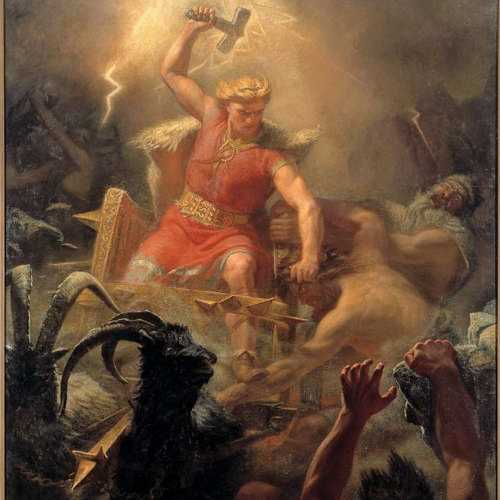Last Sunday, September 9th, was the election day in Sweden, and since this is a podcast about Sweden and Swedes, I had to cover that. But before we talk about the actual results of the election, and what changes it will lead to, let’s talk about the election process in Sweden.
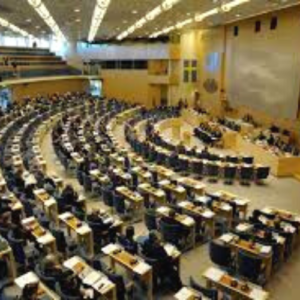
The Election Process
In Sweden, the election is held on the second Sunday of September every 4th year. There are three elections held at this time;
Riksdag (the parliament)
Landsting (the regional assembly)
Kommun (the municipal assembly)
Sweden uses proportional representation, which means that if a party gets 25% of the votes they also get 25% of the seats with one exception, to get a seat in the Riksdag a party will need to get at least 4% of the national votes. The rules are different for the regional and municipal elections which makes it easier for small and/or local parties to get represented in those elections.
The Riksdag has 349 seats and at the moment there are eight different parties represented. I will talk a bit more about those parties when we get into the result of this year’s election.
Since Sweden is a part of the European Union (EU) there is also a fourth election held every 5th year to the EU parliament, but I will not cover that in this episode.
The Responsibilities of the Three Assemblies
The Riksdag decides the laws in Sweden
The government runs the country at the national level. It does so by ensuring that the decisions made in the Riksdag are carried out. The government can also propose new laws or changes to existing laws. The Riksdag then votes yes or no to the government’s proposals. The Riksdag makes decisions that affect the entire country.
The Riksdag also makes decisions about the income and expenses of the Swedish state. The state’s expenses include universities and university colleges, the police, and child benefits.
The Riksdag and the government are both parts of what is referred to as the state.
The regions are responsible for medical care
There are 21 regions in Sweden. The most important task of the regions is to manage care services. They manage medical care, healthcare, and dental care. They are also responsible for public transport, such as buses, trams, and the metro.
Municipalities manage schools
Sweden is also divided into 290 municipalities. There are large and small municipalities. The biggest is Stockholm municipality, where almost a million people live. The smallest is Bjurholm municipality, where fewer than 3,000 people live.
Municipalities are responsible for many of the services that are provided where you live. It is the municipality that ensures you get water when you open the tap at home and that there are schools for children in your area. The municipality is also responsible for ensuring that elderly and ill people receive help when they are unable to look after themselves.
Municipalities and regions are financed via taxes
Taxes make up the biggest share of municipalities’ and regions’ income. Other sources of income are state subsidies and fees charged for services. The money is used for schools, hospitals, and roads, among other things.
Municipalities and regions are free to decide how high the taxes their residents pay should be. That is part of what is known as regional and municipal autonomy.
Who Can Vote?
The rules for who can vote and who can become a politician and run for a seat are the same. So if you are eligible to vote you are also eligible to run for a seat.
To vote for the Riksdag (parliament) you have to be at least 18 years on the day of the election. You have to be a Swedish citizen, and you have to have been a resident of Sweden at some point.
For the regional and municipal elections, the rules are a bit different. You have to be at least 18 years old and have been registered as a resident of Sweden for at least three years. You don’t have to be a citizen.
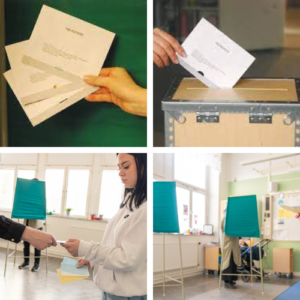
How Does the Actual Voting Work?
If you are eligible to vote you will get a voting card sent to your home address. This card will tell you what voting station you have to go to, to cast your vote. This could be in a school nearby or in any other official building.
At the voting station, you use paper ballots with the different party names on them and the name of the candidates that represent them. These ballots come in three colors;
Yellow for Riksdag (parliament)
Blue for Landsting (regional)
White for Kommun (municipal)
There is also a “blank” ballot, a ballot without any party affiliated, that you can choose.
If you want to vote for a particular candidate on a party’s list of candidates you can do so by putting an x or a checkmark in front of that personal name on the ballot.
You will get three envelopes, one for each election, and you go behind a screen to put your ballots in those envelopes.
When voting you have to show your voter’s card and an ID. Accepted identifications are ID Card, Driver’s licenses, and Passports.
You can also vote early. Early voting starts 18 days before the election date. The process is the same but instead of going to the polling station you use other locations specified by each community, often those are the post office, you use the same type of ballots and there are screens placed in these early voting locations. The early votes are then sent to the voting station you are designated to and will be part of the counting of votes at that station.
How Are the Votes Counted?
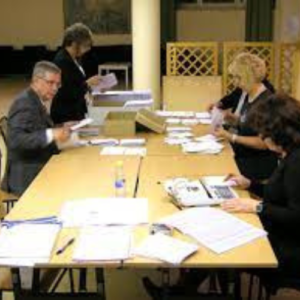
Immediately after the closing of the polls, the votes are counted in the polling stations in this order:
Parliament, municipal, and regional assembly. First, the absentee votes are put in the ballot boxes. The number of voters who have cast their votes according to the voter register is determined. The envelopes in the ballot box are counted and compared with the numbers according to the voters’ register. If there is a discrepancy, a recount is carried out. If there still is a discrepancy, this is written in the polling station report and the count continues.
The envelopes are opened, and the ballots are sorted according to party. Spoiled ballots are set aside and counted. A ballot is spoiled if: the ballot is marked so the voter can be identified;
there is more than one ballot for different parties (if ballots are for the same party one ballot is valid); if there is more than one party name on the ballot; or if there is no party name on the ballot. The ballots are then counted per party and the numbers are written in the polling station report.
The ballots are put in special plastic envelopes. A separate envelope is used for each party, and for spoiled ballots, and the envelopes are sealed. The ballots, voters’ register, and reports are delivered to the local election committee, and from there, to the state county administration for the recount.
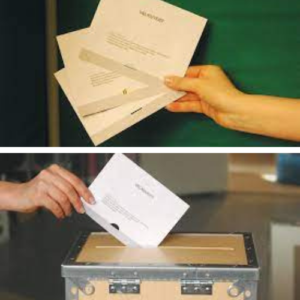
As soon as the parliamentary election is counted in the polling station, the results are reported by telephone to the Regional Tax Authority. The parliamentary results are forwarded to the National Tax Board where a preliminary distribution of seats is carried out and published. The results from the municipal and county council elections are reported in the same way, but the procedures end at the Regional Tax Authority, where preliminary distributions of seats are carried out and published.
Predictions of the parliamentary results are made by the media based on sample results delivered by the National Tax Board. The media bear the responsibility for these predictions. However, the accuracy of the predictions has improved, and normally the predictions are very close to the actual result.
The local election committees are responsible for ‘late’ absentee votes (that have not been sent to the polling stations), and mail-in votes. This count takes place three days after election day, and by and large, the same rules apply as in counting at the polling stations. The election materials are delivered to the State County Administration for a recount immediately after the count is finished.
At the final count, all ballots are examined and decided on once again. The ballots are counted, not only by party, but by each list within the party, and preferential votes for candidates. The numbers are entered into computers, the results are calculated, and seats are distributed among parties and candidates. These operations start the day after the election. The final parliamentary results are published a little more than a week later. The final county council and municipal council results are published approximately three weeks after the election.
All ballots, reports, and voters’ registers are kept in case of complaints.
In the 2018 parliamentary elections, 87.2 percent of persons eligible to vote also chose to vote. In this year’s election, it was somewhat lower at 83.84%. Compare that to the US presidential election which has an average voter turnout of around 62%.
Let’s Look at the 2022 Election
At the time of my recording, there are still some question marks, but I will try to give you an accurate as possible picture of what happened and what the consequences will be. And just a fun fact that sometimes creates confusion, in Sweden, the left parties are represented as red parties and the right parties are blue, the opposite of here in the US where red is the color of the republicans and blue of the democrats.
Let me first give a short introduction to the eight parties that were, and still will be, represented in the Riksdag.
The Eight Parties

For many years there were five parties in the Riksdag and those are easily presented on a left, middle right scale. With the three additional parties, that type of scale will be more complicated.
The traditional five parties are
Vänsterpartiet (The Left Party) / Socialdemokraterna (The Social Democrat Party) are both considered to be on the left side of the spectrum
Centerpartiet (The Center Party) / Liberalerna (The Liberal Party) are both on the middle/right side of the spectrum
Moderaterna (The Moderate Party) is on the right side of the spectrum
As I said these parties were represented for a very long time without any other parties reaching the 4% threshold to gain a seat in the Riksdag. In 1988 the first party (after 70 years) to be part of the Swedish Riksdag was Miljöpartiet (The Green Party) and they are often considered a left-center party.
The next party to get elected was Kristdemokraterna (The Christian Democrats). They first got represented by cooperation with the Center Party in 1985 by having one of their representatives on the Center Party-list. In 1991 the party got its first seat under its own name by breaking the 4% threshold. They are considered a center-right party.
The latest party to enter the Swedish Riksdag is Sverigedemokraterna (The Sweden Democrats) The party describes itself as a social conservative with a nationalist foundation. The party has been variously characterized by academics, political commentators, and the media as national-conservative, anti-immigration, anti-Islam, eurosceptic, and far-right. The Sweden Democrats reject the far-right label, saying that it no longer represents the party’s political beliefs. the party crossed the 4% threshold for the first time during the 2010 general election.
The Results of the 2022 Election
| Party | Percentage of the votes | Mandates in the Riksdag |
| The Social Democrat Party | 30.3% (+2%) | 107 (+7) |
| Sweden Democrats | 20.5% (+3%) | 73 (+11) |
| The Moderate Party | 19.1% (-0.7%) | 68 (-2) |
| The Left Party | 6.7% (-1.3%) | 24 (-3) |
| The Center Party | 6.7% (-1.9%) | 24 (-7) |
| The Christian Democrats | 5.3% (-1.0%) | 19 (-3) |
| The Green Party | 5.1% (+0.7%) | 18 (+2) |
| Liberals | 4.6% (-0.9%) | 16 (-4) |
What Will Happen Next
In order to know who can become prime minister, it must be clear how mandates have been distributed in the Riksdag and which parties can form a majority. Most often there will be either a one-party government with expressed support from other parties or a coalition government with ministers from several parties.
The sitting Prime Minister can choose to resign after the election if it is clear that there is no longer support in the Riksdag. She is then dismissed by the Speaker, but at the same time is tasked with leading a transitional government until a new government is in place.
In this election, the Speaker of the Riksdag Andreas Norlén met Prime Minister Magdalena Andersson (Social Democratic Party) at the Riksdag. Magdalena Andersson had announced that she intended to submit her request to be dismissed from office to the Speaker. Magdalena is now leading a caretaker government in accordance with the rules of the Instrument of Government.
it is the Speaker’s task to bring forward a new candidate that the Riksdag can tolerate. The Speaker invites all party leaders to a meeting to gauge who can possibly receive sufficient support, a process that is usually referred to as the speaker’s round.
The Speaker will now speak to the representatives of the Riksdag parties individually, during the so-called speaker rounds, and the speaker submits his proposal for a new prime minister to the Riksdag.
After each parliamentary election, there is also a speaker election, which means that it can be one speaker who initiates the formation of the government and another who takes it to the finish line.
When the Riksdag votes on the speaker’s proposal, the principle is that the new prime minister can take office if there is not a majority that says no. Parties that accept the proposal can therefore say yes. They can also opt out of voting. If there is a majority of no votes, new speaker rounds will start. The speaker can deliver four proposals. If all of them are ejected there will be an extra election where the process starts all over.
When the Riksdag approves a new prime minister, it also approves which parties will form part of the government. Then the new prime minister must deliver his declaration of government in the Riksdag as soon as possible. It describes in broad strokes what policy the new government intends to pursue and who will become ministers. After that, the formal change of power takes place at a council with the king.
Where Are We Now
The Swedish Priminister has, as I mentioned, decided to resign and the speaker’s rounds have started. On Tuesday, September 27 The Riksdag will open, and the speaker can suggest a new prime minister. Until a new prime minister is elected the resigning prime minister will be in charge of a transitional government.
From all reporting so far Ulf Kristersson, the party leader for the Conservative Party (Moderaterna) has already begun informal negotiations over who will sit in his cabinet.
His party had a pre-electoral alliance with the Christian Democrats, Liberals, and Sweden Democrats.
But internal divisions are already apparent. The Sweden Democrats, took over 20% of the national vote to become the second largest party in the country – and the largest on the right. They can thereby make a strong claim to be a significant player in the government. However, in order to form a parliamentary majority, Kristersson needs the support of the Liberals, and they’ve said they would not support a cabinet where the Sweden Democrats hold ministerial posts. The likely outcome will be a Kristersson government without a formal Sweden Democrats presence.
Instead, Sweden Democrats will exert their influence outside the government through a formal contract with the Conservatives. The contract will outline the policies that the Sweden Democrats want to see implemented in exchange for their parliamentary support.
So there are still not totally clear who will become the next prime minister, or who will have a seat in the government. The only sure thing, for now, is that we will have a shift from left to right, even if the margin is very narrow.



